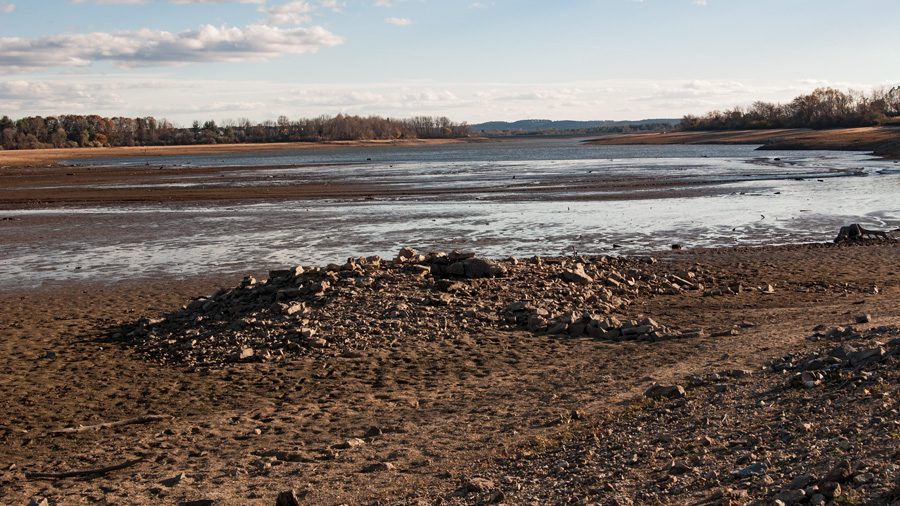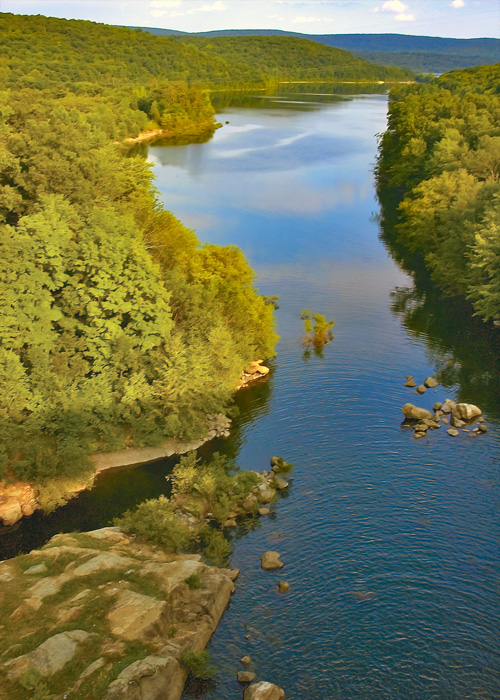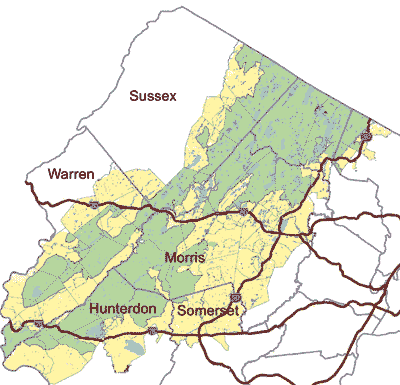Scanning the depths of Round Valley Reservoir, sonars track lake trout and largemouth bass under the fishing boats. Every so often large blocks, the ruined foundations of old homes, appear at the bottom of the screen. Submerged for half a century under fifty-five billion gallons of water, the last vestiges of a small farm community are all that remain of heartache and sacrifice.

In 1958, the newly created Water Supply Law authorized the formation of two reservoirs in Hunterdon County. Spruce Run and Round Valley, a horseshoe-shaped bowl cradled by the Cushetunk Mountains, offered ideal locations. Distraught landowners tried unsuccessfully to save their homes. The state compelled the farmers to sell off land their families had occupied for generations. Despite a severe, prolonged drought, by the mid '60s both reservoirs were fully operational.

Forty-years later, looking out over the vast, shimmering surface, visitors see water for drinking, water for manufacturing, water for recreation. Few remember the displaced farmers' distress and acrimony. It is, after all, the story of reservoirs around the country: the wishes of the few were sacrificed for the needs of the many.
Of the people who enacted and carried out the state's plan, Henry S. Patterson, III, Executive Director of New Jersey Water Supply Authority, says simply, "they should be commended for their foresight. They anticipated our needs." Regarding the possibility of more reservoirs and displaced communities, he adds, "It can't happen again. There is no additional reservoir capacity in the state."
Today, water from the northwest corner of the state is dispersed through the region by a slew of contracted allocations. The complex system of stream and river augmentation reservoirs draws water from a portion of the rugged, hilly, 1,250 square mile region known as New Jersey's Highlands. Containing seven major, indispensable drainage basins, the region covers portions of seven counties Bergen, Hunterdon, Morris, Passaic, Somerset, Sussex and Warren and eighty-eight municipalities. Five major reservoir systems the Croton, Wanaque, Newark, Jersey City and Raritan Basin supply more than 420 million gallons per day of water to approximately 50 percent of New Jersey residents: 100% of Highlands residents get their water from the Highlands, along with 800,000 residents of Somerset, Mercer, Middlesex and Union counties, and 900,000 people in Newark and Jersey City.
For most New Jersey residents, water is a present and future certainty. Except in times of drought, water pours from the tap, the hose, the spigot. The potential for disaster caused by building in key Highlands watersheds is understood by only a small segment of the population. But those who understand are alarmed and ready to fight.
The formation of Round Valley and Spruce Run would be an early, relatively quiet salvo in a battle over resources.

For many environmentalists, development serves as a synonym for sprawl. Growing population centers bring substantial negative impacts. The spread of impervious surface from parking lots to garden decks acts as a barrier to the recharge needed for groundwater. Without a filter, sediments and pollutants spill into the streams, lakes, and reservoirs. The destruction of New Jersey's forests leads to additional run-off. In the Highlands, where thousands of acres are lost annually and the population growth rate is 50% higher than the rest of the state, the problem threatens to become acute. Damage to sensitive areas that feed into the reservoirs will incur staggering costs; NJWSA estimates subsequent pipelines and water purification plants for the Hunterdon County reservoirs to reach $30 billion within two generations.
In the spring of 2004, Senate meetings built support for the Highlands Preservation Act. At a Senate Environment Committee meeting in March 2004, Department of Environmental Protection Commissioner Bradley M. Campbell warned "the destruction of watershed lands (will) create surface runoff that accelerates erosion and brings additional contaminates into the waterways."
For planners at the state level, the solution lies in regional oversight. Ringwood, in northern Passaic County, became a compelling argument against home rule (where local municipalities determine growth and zoning restrictions within their boundaries). David Epstein, Executive Director, Morris Land Conservancy, displayed a map of Ringwood Township's 500-acre industrial zone, and pointed out "almost every lot zoned for heavy industry has a stream feeding into the Wanaque and Monksville reservoirs, that provide 2 million people with drinking water." As Lebanon Township Mayor Eileen Swan, an advocate of a comprehensive regional approach, noted, "if home rule worked efficiently, the Highlands would already have been saved".
As word of the proposed legislation spread, opponents of the bill joined forces. At increasingly crowded and rancorous public meetings, the debate shifted from issues of water to issues of property rights and land usage. Builders speculated about lost jobs and a lack of provisions for new housing. Some property owners feared devaluation or an outright land grab, on a par with the Delaware River Tock's Island debacle of the 1960s, when homes and towns were forcibly abandoned for a dam that was never built.
Nonetheless, when asked in a Save The Highlands survey if the State should create a regional plan for the Highlands, almost 96% of public respondents answered "yes". On June 10, 2004, the New Jersey Senate and Assembly passed the Highlands Water Protection and Planning Act by an overwhelming majority. The Highlands Bill would represent the most ambitious environmental program since the Pinelands Preservation Act of 1979 regulated development in 295,000 acres in a protection area of more than 900,000 acres. The Highlands Act designated 395,000 acres as a Preservation Area, and sharply curtailed development in 145,000 acres of private and municipal property. Critical watershed land would be protected through land-acquisition of key parcels and regulation programs; a regional council would have veto power over large-scale development. Tough environmental regulations -- banning, for example, development on steep slopes, along streams and in forests -- would begin immediately.
Builders were appalled. Environmentalists were ecstatic.
The following weekend, Dennis Schvejda, Conservation Director, New Jersey Chapter Sierra Club, led a hike at Wyanokie High Point. The group stretched their legs and enjoyed the salvation of a state treasure. Their celebration would be painfully brief. Word spread of a "smart growth" bill offered as a compromise to builders. Kept under wraps until Friday evening, the "Smart Growth Bill", otherwise known as Fast-track legislation, would expedite the building permit process in mandated growth areas. Among the provisions in the bill: automatic approval of certain environmental permits that are not responded to in a scant 45 days. Despite protests by environmental groups, the Fast-Track legislation was approved.
Governor McGreevey signed the Highlands Water Protection and Planning Act on August 10th. Many environmental groups, including the New Jersey Audubon Society, the Sierra Club, and the New Jersey Environmental Federation, boycotted the ceremony.
The Hunterdon and Warren County Freeholder Boards passed resolutions condemning the Highlands Act. Opponents worried that towns inside and around the preserved area will be forced to bear the cost of aggressive preservation programs. The two bills seemed to deliver a one-two punch to communities: they threatened more sprawl in mandated growth areas, and a decreased tax base in towns without growth centers. Towns unable to raise adequate funds could presumably devolve into welfare clients of the state, dependent on aid from Trenton.
Farmers who work the 32,000 acres in the protection zone worry that the state will not have enough money to buy development rights. Many have little faith in the Transfer of Development Rights law, signed March 2004, that provides top market value for land taken off the development rolls.
They are valid concerns.
Standard & Poors responded to the massive debt in New Jersey's budget by promptly lowering the state's bond rating. In a press release, S&P offered its reason for the downgrade: "(New Jersey), which has borrowed to balance its budget in each of the last three fiscal periods, has shown an apparent unwillingness to take appropriate actions to achieve structural balance." The stage is set for a battle over priorities: money for TDRs versus money for an almost insolvent Transportation Trust Fund.
In a budgetary crisis, commercial real estate resembles a cash cow. According to the New Jersey Chapter of the National Association of Industrial and Office Properties, in 2002, the last year the numbers were compiled, New Jersey received $3.5 billion in commercial property taxes. The pressure to build will only increase.
Proponents argue that the economy is tied to water as well as to land. Products created from Highlands water cut across industries: Viagra, Haagen-Dazs, Goya beans, Progresso Soup, Drakes Cakes, Valium, Tylenol.
In Newark, the Anheuser-Busch brewery used water from the Wanaque and Monksville reservoirs to produce over 233 million gallons of beer in 2003. On a smaller scale, the Long Valley Pub and Brewery produces approximately 1,000 barrels annually. "We use municipal water, with a charcoal filter to remove the taste of chlorine," Joe Saia, the Head Brewmaster, explains. "It takes three to four gallons water produce one gallon beer. We're lucky here. The Ph is nice and the total hardness is just perfect. We take it for granted that we get clean water from the tap."
Economics skirt the issue around our most basic needs. As Former Mayor Sam Bagby, in the movie Chinatown, put it: "Without water the dust will rise up and cover us as though we'd never existed."
At best, the Highlands Act offers a shield. Uncertainty surrounds the bill; a key feature of the regional master plan allows for revisions and updates at least once every five years. A council of political appointees controls veto power over construction in the core area. Development will be slowed, not halted. Around the watershed lands, only money for state acquisition can stop the loss of large tracts of land.
Not far from Routes 78 and 287, Tewksbury Township offers a vision of idyllic rural life. Horse farms, orchards, scenic roads and country stores grace the land. Increasingly, that vision is interrupted by very larger homes carved into the hillsides. Rural areas "are dying a slow death" from development, says Ted Koven, president of the Tewksbury Land Trust. Tewksbury and nearby Lebanon Township, afraid of continued losses, threw their support behind the Highlands plan, and asked for inclusion of important township lands in the plan.
In Lebanon Township, a gathering of politicians and state employees celebrated the acquisition of the Pelio Farm. Purchased with county, municipal, nonprofit and state partners, the farm's 298 acres represented an attempt to create a green belt in the heart of key watershed lands.
McMansions, their green lawns devoid of trees, flank the road leading to the secluded farm. Behind the new homes, a dirt road led to rolling hills, cornfields, and stands of trees. The property owners no doubt appreciate real estate's rule of "location, location, location". While losses frequently haunt residential areas near mandated growth centers, homeowners near the Pelio farm will likely accrue value from a new park abutting their back yards. But on August 12, the crowd focused on the big picture, which included a map showing the tantalizing proximity of Pelio farm and two preserves.

Mayor Swan, Commissioner Campbell and Senator Leonard Lance thanked contributors and praised Governor McGreevey. The Governor, a driving force behind the Highlands Bill, would announce his resignation that afternoon. While volcanic upheavals would change the political landscape, the effort to preserve the natural landscape would continue. Commissioner Campbell, surrounded by blue skies and rolling cornfields, warned of the need to continue preservation efforts, "lest the land become an empty parched monument to our collective folly."